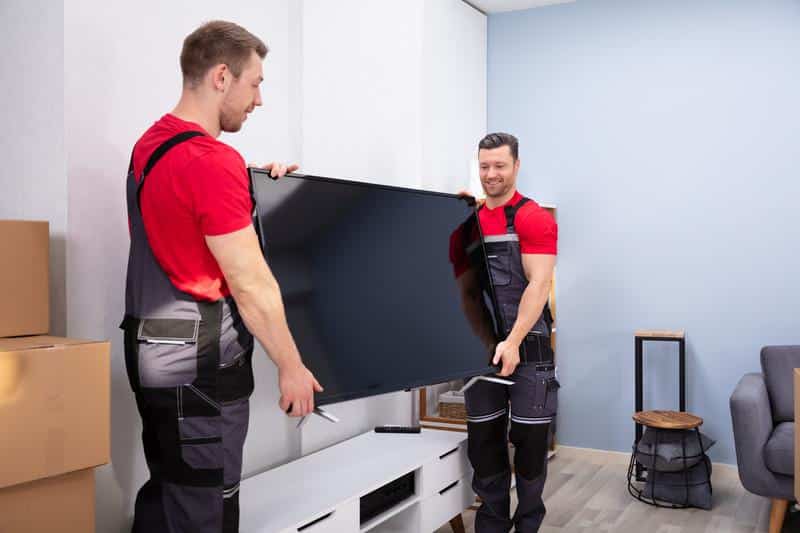
These days, flat-screen televisions are some of the best available televisions are there. But these come with a high price tag.
Therefore, when it comes to the transportation of the flat TV screen, you need to provide additional care.
By following these tips offered by long distance movers, you can easily and safely transport a flat-screen TV.
Table of Contents
Procedure to Move a Flat-screen TV
As we mentioned earlier, transporting a Flat Screen TV is a tough job considering the fragile nature of the machine. Here, we have made it easier for you by offering you a detailed guide on the procedure of transporting a flat-screen TV. So, here it goes:
Step no. 1: Prepare the flat-screen TV to move
First of all, carefully remove the flat-screen TV mounted on the wall. Ask your friends or family members to help you with removing the TV from the wall. Disconnect any cables that are connected to the TV.
Place all the screws and base in a bag together so these can be used as it is to mount on the wall at your new location. Pack this bag as well as a TV in the same box reducing the chances of losing screws and cables of the TV.
You can also take a snap of all the connection points so it will help connect it again at the new location. When it comes to preparing the flat-screen TV, make sure that you clean the display of it. Gently wipe the TV screen using a tint-free cloth.
Step no. 2: Cover up the screen
Remember that screen is the most sensitive part of a TV therefore, we need to provide the most security to it. Using foam pieces can help you in providing safety to your TV screen which will prevent it from shifting. Place two to three foam pieces at a time on the TV screen to offer additional security to it.
Then use bubble wrap to cover the entire TV so you can prevent the TV from any kind of scratches. Cushioning, blanket, furniture pads can also be used to shield the TV to safeguard it from scratches during transportation.
Step no. 3: Tips to pack your TV
Make sure you keep the TV upright while placing it inside the box for transportation to safeguard its screen during transportation. In most cases, you need to telescope two boxes to fit the flat TV screen. If you already have the box of the TV then you can use it.
Placing it inside the original box of the TV is the easiest and the effective way of packing TV. You can pack multiple-sized screens in these card boxes. Depending on the size of the TV, you can buy a heavy-duty cardboard box as per your choice.
Step no. 4: Secure the TV using padding
Once you can put the TV in the box, it is time to introduce padding into the box to stop the movement of the TV during transportation. Use furniture pads, if you see any space inside the box. Make sure the TV is tight and secure fit into the box. Once the padding is done, secure the boxes using tape.
Step no. 5: Moving and loading of the TV box by cross-state movers
Make sure you keep it upright while loading the TV box into the moving truck. It is recommended you to load it near to the mattresses and at other flat objects. Finally, your TV is ready for transportation.
Can you lay flat-screen TV down to move it to a new place?
All televisions are the most fragile electronic items therefore when it comes to transportation, we have to pay additional attention to every component of it. There are four basic types of TVs are available named rear projection, direct view, LED and plasma. Most of the homeowners have the LED and plasma TVs present at their home.
One of the biggest differences between the LED and plasma TVs is that screen nature is different. The plasma TVs have a glass screen while LED’s have one plastic layer on that. This is the reason why plasma screens can’t lay down to move to another place while LEDs can be placed down without worrying about the damage of the screen.
If proper support and padding are provided then you can lay any flat screen down and can ship it safely at your new location. It is also recommended you to check the instructions given on the outside of the box to make sure that you are shipping it right.
The real facts about laying flat-screen TV during transportation
When it comes to moving a flat-screen TV there are a lot of misconceptions are out there. Like “never lay a TV flat when it comes to shipping”, some say “laying a flat panel on the floor can cause a delaminating process that can permanently damage the television screen”.
Now let us know the real facts
It is important to distinguish the misconceptions with the real facts to know what is true. As discussed above there are two types of TVs are available mainly.
Plasma screens
It consists of the double layers of glass that is used to produce an image. It is a similar sort of technology where a light bulb is used.
LCD (Liquid crystal display)
It contains millions of pixels, sub-pixels that create the picture using RGB (red, blue, and green) colors. It produces light in different percentages to create an image or picture on the screen.
Therefore there are no flat screens that are filled with the floating gasses, nothing will settle to the bottom and you can easily lay down the TV screen. Therefore it will not harm your TV if you lay it down while transportation. But again it is your responsibility to add padding to it before you lay it down to ensure complete safety during transportation.
But remember that it is bad to lay the TV down flat. Here is Why?
Both the larger LEDs and plasma are designed in a way to stand upright to balance the weight it. So if you will lay the screen then you would not be able to give adequate support in the middle while if you stand it upright, you can make it stand upright.
Because there will be vibrations during transportation and shipping, it will increase the chance of cracking and damaging the TV screen. So, it is important to protect your investment by keeping it upright.
How to store flat-screen TV?
As you know flat-screen TVs are light and thin, therefore, it is necessary to give them extra attention when it comes to the storage of flat-screen TV.
Because of lightweight, though these TVs are easier to move but remember that these are very delicate, therefore, you need to pay attention while moving, after all, we all know that these come with a high price tag.
No matter whether you are stowing it away for a small renovation project or whether for a temporary move and you don’t want to take TV with you, you need to keep it stored with extra care to prevent it from any kind of damage.
Keep it dust-free
While storing make sure that you keep it dust-free. Do you know dust is the biggest cause of damage to a flat-screen TV? Because dust can get in air vents blocking the paths and can cause serious damage to the internal working parts of a TV or any other electronic item.
So before storing, make sure you keep it dust-free. Clean it using a soft and tint-free, microfiber cloth before you store it. Immediately cover the TV with plastic wrap to keep it free of dust and any kind of scratches during storage.
Find the perfect tight fit packaging option
If you have saved the original box of the TV then you don’t have to worry about anything because the original box is the most effective and easiest way to store your TV safely. It adds bonus protection to the corners and the screen of the television. If you don’t have the original box, you should buy a heavy-duty card box that matches the size of your television.
Consider the position of the TV
Flat-screen TVs should be stored upright in a direction to keep the screen of the TV protected. Make sure you mark which way is the up at the outside of the box so while storing or loading, it will become easier to lay it down.
Choose the right placement
Make sure that you put nothing on top of the TV box either while loading or storing. Make sure there is no pressure on the screen else serious damage can be caused. It is also recommended you to keep all the heavy items away from the TV box.
Temperature
Do you know extreme temperatures can damage or harm your TV? Make sure you keep it in a climate control area.
If it is not possible for you to do the task on your own to ship flat TV then it is recommended you to take help from Pricing Van Lines so you can ship or move your TV safely while saving yourself a huge investment. No matter whether you do it on your own or whether you hire movers, make sure the shipment is safe and efficient.

